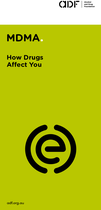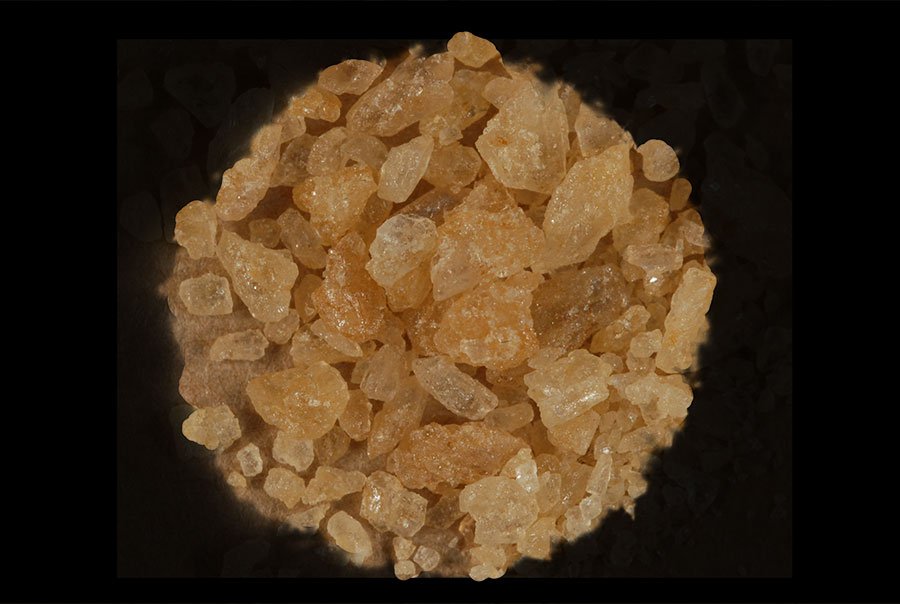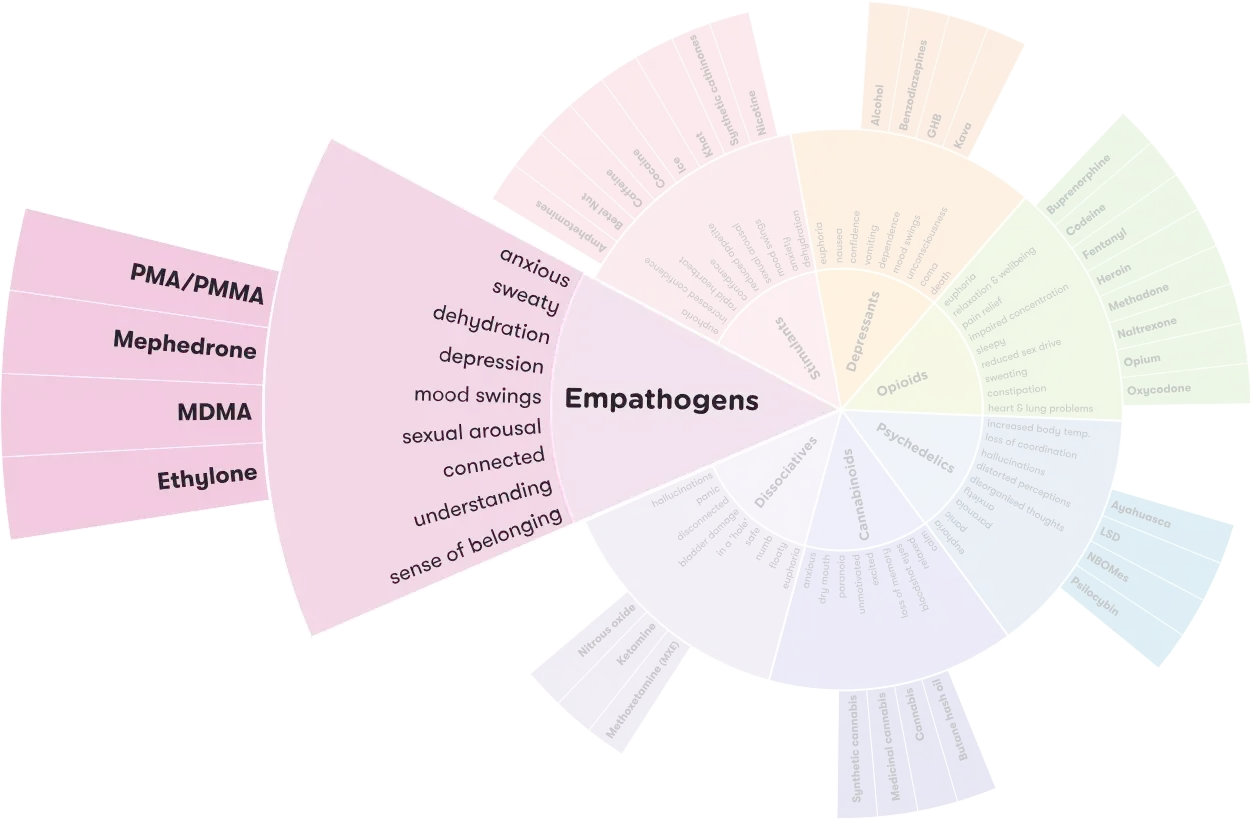
Ecstasy: How drugs affect you (bundle of 50)
Pamphlets
$39.95 (inc. GST)
View in ADF Shop
How is MDMA used?
MDMA is usually swallowed but can also be injected, snorted or inserted rectally.2
Effects of MDMA
Use of any drug can have risks. It’s important to be careful when taking any type of drug.
MDMA affects everyone differently, based on:
- size, weight and health
- whether the person is used to taking it
- whether other drugs are taken around the same time
- the amount taken
- the strength of the drug (varies from batch to batch)
- environment (where the drug is taken).
The effects of MDMA are usually felt about 20 minutes to an hour after it’s taken and last for around three to four hours.2, 3 The height of this experience is sometimes known as ‘peaking’.2
You may experience:
- euphoria
- feeling energetic and confident
- dilated (enlarged) pupils
- jaw clenching and teeth grinding
- heightened senses (sight, hearing and touch)
- excessive sweating and skin tingles
- muscle aches and pains
- reduced appetite
- fast heartbeat
- increased blood pressure
- dehydration
- heat stroke
- drinking extreme amounts of water (can cause death).2-5
If you take a large amount or have a strong batch of MDMA, you may also experience:
- floating sensations
- perceptual changes, such as visual and auditory hallucinations
- out-of-character irrational behaviour
- anxiety
- irritability, paranoia and aggression
- vomiting
- high body temperature
- racing heartbeat
- convulsions.2, 4, 5
MDMA, dehydration and overheating
MDMA is taken by some people at festivals, parties, and nightclubs. In these environments, people using MDMA are likely to engage in dancing, which in combination with MDMA can raise body temperature to a dangerous level.6
It is important people take regular breaks to cool down and drink around 250-500ml of water per hour.
Drinking too much water while taking MDMA is dangerous. Deaths have occurred from dilutional hyponatremia — this is a condition where a person’s brain swells from drinking too much water and can lead to coma.6
Impact of mood and environment
Drugs that affect a person’s mental state (psychoactive drugs) can also have varied effects depending on a person’s mood (often called the ‘set’) or the environment they are in (the ‘setting’):
- Set: a person’s state of mind, previous encounters with psychedelic drugs, and expectations of what’s going to happen. For example, feelings of stress or anxiety before using MDMA may result in an unpleasant experience.7
- Setting: the environment in which someone consumes MDMA – whether it’s known and familiar, who they’re with, if they’re indoors or outdoors, the type of music and light. For example, using MDMA in a calm, quiet and relaxed environment can lead to, or contribute to, a pleasant experience but being in a noisy, crowded place may result in a negative experience.7
- Being in a good state of mind, with trusted friends and a safe environment before taking MDMA reduces the risk of having an unpleasant experience.
Coming down
In the days after MDMA use, you may experience:
- restless sleep and exhaustion
- anxiety, irritability and depression
- paranoia (feeling extremely suspicious and frightened)
- difficulty concentrating.2-5
The use of depressant drugs such as alcohol, benzodiazepines or cannabis to help with these ‘come down’ effects, may result in dependence on both types of drugs.
Long-term effects
Regular use of MDMA may cause:
- colds or flu
- depression
- needing to use more to get the same effect
- dependence on MDMA
- memory and concentration problems
- liver problems
- financial, work and social problems.2-4
Mixing MDMA with other drugs
The effects of taking MDMA with other drugs − including over-the-counter or prescribed medications − can be unpredictable and dangerous:
MDMA + alcohol: increased risk of dehydration and consequently drinking too much water.8
MDMA + ice, speed or cocaine: increased risk of anxiety and reduced brain functioning due to dopamine depletion. Enormous strain on the cardiovascular system and other parts of the body, which can lead to stroke.9,10
MDMA + antidepressants: Drowsiness, clumsiness, restlessness and feeling drunk and dizzy.11
More on Polydrug use
Polydrug use is a term for the use of more than one drug or type of drug at the same time or one after another. Polydrug use can involve both illicit drugs and legal substances, such as alcohol and medications.
Reducing Harm
- Try a smaller dose first and wait 2 hours before taking more
- Avoid taking high doses. Higher doses are more likely to cause an unpleasant, overwhelming experience (particularly for first time use)
- Avoid mixing with other drugs including alcohol as this can cause dehydration
- Some medications interact with MDMA, always check first before taking
- Take regular breaks to cool down and drink around 250-500ml of water per hour
- Let a friend know what you’ve taken so they can help if you’re unwell
- Avoid taking MDMA too frequently. According to some people who use MDMA, if taken too frequently, MDMA can stop working which can result in taking more to get the same result.12, 13
Withdrawal
Giving up MDMA after a long time is challenging because the body has to get used to functioning without it. Withdrawal symptoms should settle down after a week and will mostly disappear after a month. Symptoms include:
- cravings for MDMA
- aches and pains
- exhaustion
- restless sleep
- agitation
- trouble concentrating
- anxiety and depression.14
Getting help
If your use of MDMA is affecting your health, family, relationships, work, school, financial or other life situations, or you’re concerned about someone else, you can find help and support.
Call the National Alcohol and Other Drug Hotline on 1800 250 015 for free and confidential advice, information and counselling about alcohol and other drugs
Help and Support Services search
Find a service in your local area from our list. Simply add your location or postcode and filter by service type to quickly discover help near you.
If you're looking for other information or support options, send us an email at druginfo@adf.org.au
Path2Help
Not sure what you are looking for?
Try our intuitive Path2Help tool and be matched with support information and services tailored to you.

Australian Federal and State laws provide penalties for possessing, using, making or selling MDMA, or driving under its influence.
See also, drugs and the law.
National
- 12.5% of Australians aged 14 years and over have used MDMA one or more times in their life.15
- 3.0% of Australians aged 14 years and over have used MDMA in the previous 12 months.15
Young people
- Young Australians (aged 14–29) first try MDMA at 18.7 years on average.15
- 6% of 12-17 year olds have tried MDMA16
- European Monitoring Centre for Drugs and Drug Addiction. Drug profiles: glossary Empathogens 2018 [cited: 23.06.2022].
- Black E, Shakeshaft A, Newton N, Teesson M, Farrell M, Rodriguez D. "Party Drugs"/MDMA/Ecstasy - What you need to know. Sydney: National Drug and Alcohol Research Centre; 2017.
- Campbell A. The Australian Illicit Drug Guide: Every Person's Guide to Illicit Drugs--Their Use, Effects and History, Treatment Options and Legal Penalties: Black Inc.; 2001.
- Brands B, Sproule, B. & Marshman, J., editor. Drugs & drug abuse. 3rd ed. Ontario: Ontario: Addiction Research Foundation.; 1998.
- Upfal J. The Australian Drug Guide: Every Person's Guide to Prescription and Over-the-counter Medicines, Street Drugs, Vaccines, Vitamins and Minerals. 7th ed. Melbourne: Black Inc.; 2006.
- Moritz ML, Kalantar-Zadeh K, Ayus JC. Ecstacy-associated hyponatremia: why are women at risk? Nephrol Dial Transplant. 2013;28(9):2206-9.
- Nutt D. Drugs without the hot air : making sense of legal and illegal drugs. Cambridge: UIT Cambridge Ltd; 2012.
- Hernández-López C, Farré M, Roset PN, Menoyo E, Pizarro N, Ortuño J, et al. 3,4-Methylenedioxymethamphetamine (Ecstasy) and Alcohol Interactions in Humans: Psychomotor Performance, Subjective Effects, and Pharmacokinetics. Journal of Pharmacology and Experimental Therapeutics. 2002;300(1):236.
- Institute NDR. National Amphetamine-Type Stimulant Strategy Background paper. Curtin University; 2007.
- Vera B, Vidal Giné C, Lozano O, Fernández Calderón F. Harm reduction behaviors among polysubstance users who consume ecstasy: can they reduce the negative consequences? An exploratory study. Drugs: Education, Prevention and Policy. 2020;27(1):49-59.
- Copeland J, Dillon P, Gascoigne M. Ecstasy and the concomitant use of pharmaceuticals. Addictive Behaviors. 2006;31(2):367-70.
- Dance Safe. What is MDMA? 2022 [cited: September 2022].
- Drug Science.MDMA (Ecstasy) 2022 [cited: September 2022].
- Julien R, Advokat C, Comaty, J. A primer of drug action. 12 ed. New York: Worth Publishing; 2011.
- Australian Institute of Health and Welfare. National Drug Strategy Household Survey 2019 2020 [cited: September 2022].
- Guerin N, White V. ASSAD 2017 Statistics & Trends: Australian Secondary Students’ Use of Tobacco, Alcohol, Over-the-counter Drugs, and Illicit Substances. Centre for Behavioural Research in Cancer: Cancer Council Victoria; 2018.

